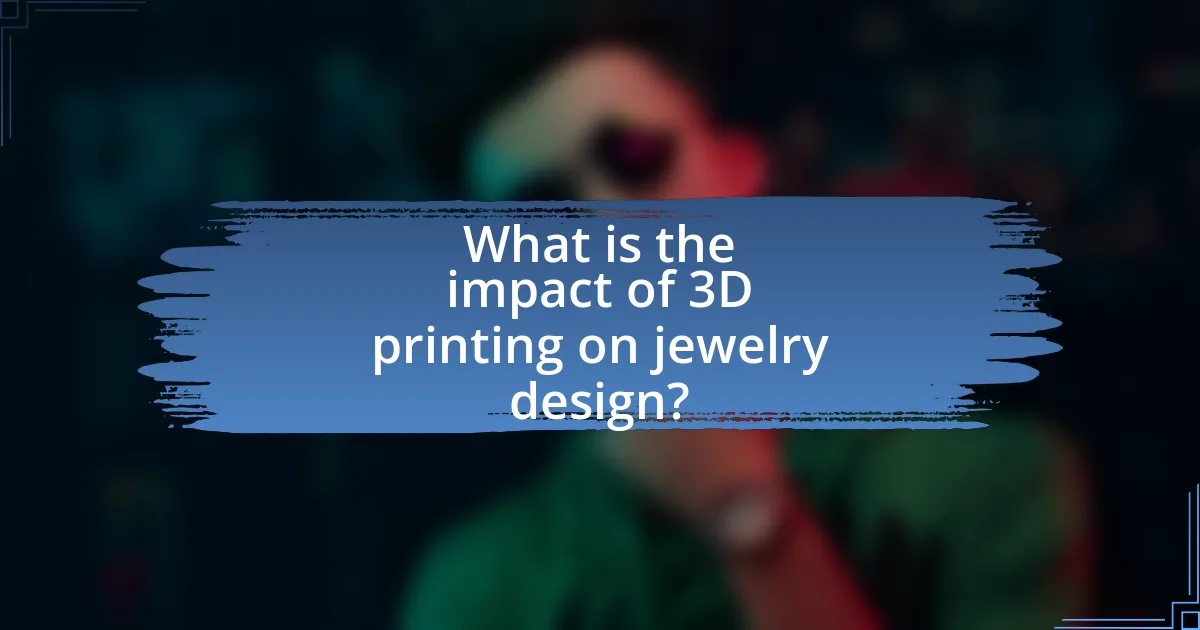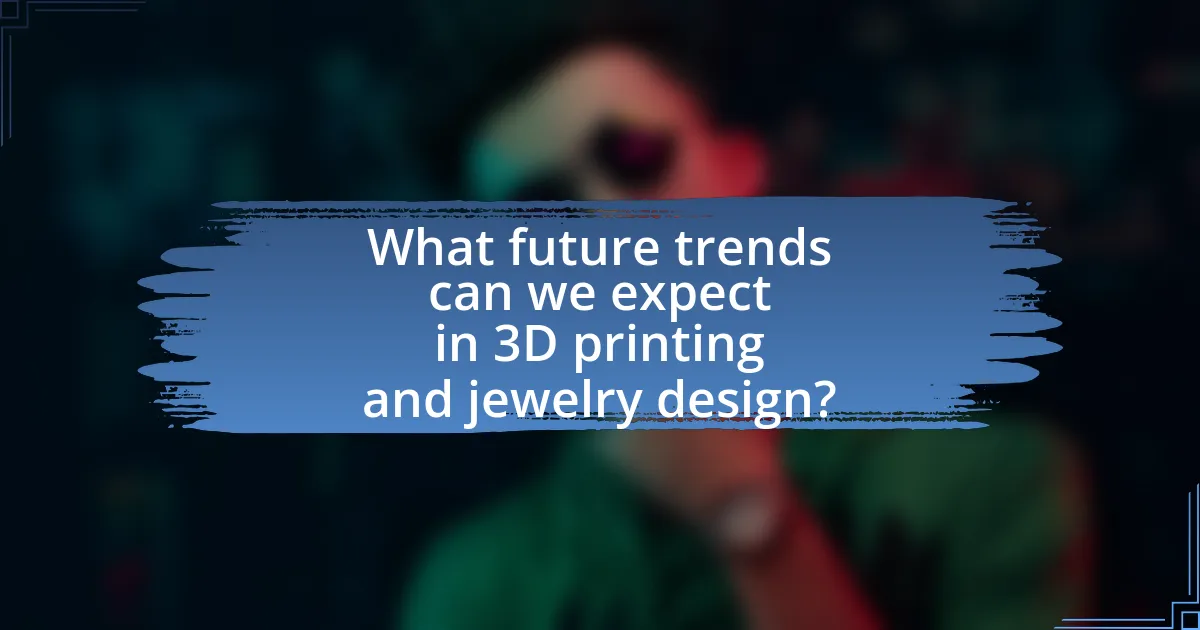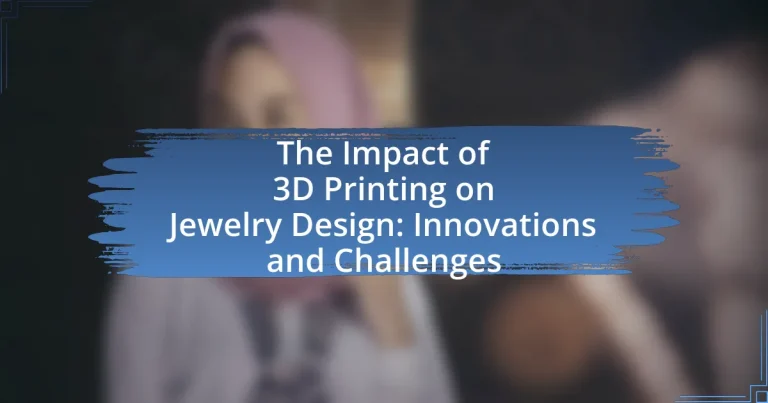The article examines the impact of 3D printing on jewelry design, highlighting its transformative effects on traditional practices, innovations, and challenges faced by the industry. It discusses how 3D printing enables intricate designs, rapid prototyping, and enhanced customization, significantly reducing production time and costs. Key advantages include increased personalization for consumers and sustainability through reduced material waste. However, challenges such as quality control, material limitations, and intellectual property concerns are also addressed. The article concludes by exploring future trends and best practices for integrating 3D printing into jewelry design.

What is the impact of 3D printing on jewelry design?
3D printing significantly transforms jewelry design by enabling intricate and customizable creations that were previously difficult or impossible to achieve through traditional methods. This technology allows designers to produce complex geometries and fine details with high precision, reducing the time and cost associated with prototyping. For instance, a study by the University of Illinois found that 3D printing can decrease production time by up to 90% compared to conventional techniques. Additionally, 3D printing facilitates on-demand production, allowing designers to create unique pieces tailored to individual customer preferences, thus enhancing personalization in the jewelry market.
How has 3D printing transformed traditional jewelry design practices?
3D printing has significantly transformed traditional jewelry design practices by enabling rapid prototyping and customization. This technology allows designers to create intricate and complex designs that were previously difficult or impossible to achieve with traditional methods. For instance, 3D printing can produce detailed geometries and personalized pieces tailored to individual customer specifications, enhancing the uniqueness of each item. According to a report by Wohlers Associates, the 3D printing industry in jewelry is projected to grow substantially, indicating a shift in how jewelry is conceptualized and manufactured. This transformation not only streamlines the design process but also reduces material waste, making it a more sustainable option compared to conventional techniques.
What are the key innovations introduced by 3D printing in jewelry design?
3D printing has introduced several key innovations in jewelry design, including rapid prototyping, customization, and complex geometries. Rapid prototyping allows designers to quickly create and iterate on designs, significantly reducing the time from concept to final product. Customization enables consumers to personalize jewelry pieces, catering to individual preferences and styles, which has become increasingly popular in the market. Additionally, 3D printing facilitates the creation of intricate and complex geometries that are difficult or impossible to achieve with traditional manufacturing methods, enhancing the artistic possibilities in jewelry design. These innovations have transformed the industry by increasing efficiency, personalization, and creativity in jewelry production.
How does 3D printing influence the creative process for jewelry designers?
3D printing significantly influences the creative process for jewelry designers by enabling rapid prototyping and customization. This technology allows designers to quickly create intricate and complex designs that would be difficult or impossible to achieve through traditional methods. For instance, designers can iterate on their concepts in real-time, reducing the time from idea to final product. Additionally, 3D printing facilitates the use of unique materials and textures, expanding the creative possibilities. According to a study published in the Journal of Fashion Technology & Textile Engineering, 3D printing has been shown to enhance innovation in jewelry design by allowing for more personalized and unique pieces, thus transforming the traditional design workflow.
What are the advantages of using 3D printing in jewelry design?
The advantages of using 3D printing in jewelry design include enhanced customization, reduced production time, and cost efficiency. Enhanced customization allows designers to create intricate and personalized pieces that meet specific customer preferences, as 3D printing enables the production of complex geometries that traditional methods cannot achieve. Reduced production time is evident, as 3D printing can significantly shorten the design-to-production cycle, allowing for rapid prototyping and quicker market entry. Cost efficiency is achieved through the minimization of material waste and the ability to produce small batches economically, which is particularly beneficial for independent designers and startups. These advantages collectively contribute to a more innovative and flexible jewelry design process.
How does 3D printing enhance customization options for consumers?
3D printing enhances customization options for consumers by allowing the creation of unique, personalized designs tailored to individual preferences. This technology enables consumers to modify existing designs or create entirely new pieces, accommodating specific tastes, sizes, and styles. For instance, a study by Wohlers Associates in 2021 highlighted that 3D printing can produce intricate jewelry designs that traditional manufacturing methods cannot achieve, thus expanding the range of customization available. Additionally, the ability to quickly prototype and iterate designs means consumers can engage in the design process more interactively, resulting in products that reflect their personal identity and preferences.
What cost benefits does 3D printing offer to jewelry designers?
3D printing offers significant cost benefits to jewelry designers by reducing material waste and lowering production costs. Traditional jewelry manufacturing often involves extensive material loss during the casting process, whereas 3D printing utilizes only the necessary amount of material, resulting in up to 90% less waste. Additionally, 3D printing allows for rapid prototyping, enabling designers to create and iterate designs quickly without the high costs associated with traditional molds and tooling. This efficiency can lead to lower overall production costs and faster time-to-market for new designs.
What challenges does 3D printing present to the jewelry industry?
3D printing presents several challenges to the jewelry industry, including issues related to quality control, material limitations, and intellectual property concerns. Quality control is a significant challenge, as 3D-printed pieces may not always meet the high standards of craftsmanship expected in traditional jewelry, leading to inconsistencies in finish and durability. Material limitations also pose a problem; while 3D printing allows for innovative designs, the range of materials suitable for high-quality jewelry is still limited compared to traditional methods. Additionally, intellectual property concerns arise as the ease of replicating designs through 3D printing can lead to increased instances of counterfeiting and design theft, undermining the value of original creations.
What technical limitations do designers face when using 3D printing?
Designers face several technical limitations when using 3D printing, including material constraints, resolution issues, and post-processing requirements. The range of materials suitable for 3D printing is often limited, as not all materials can achieve the desired strength, flexibility, or finish required for jewelry. Additionally, the resolution of 3D printers can affect the level of detail in designs; lower resolution printers may not capture intricate features, leading to a loss of design fidelity. Furthermore, many 3D printed items require significant post-processing, such as sanding or polishing, to achieve a professional appearance, which can be time-consuming and labor-intensive. These limitations can hinder the creative process and the overall quality of the final product in jewelry design.
How does the adoption of 3D printing affect traditional craftsmanship?
The adoption of 3D printing significantly alters traditional craftsmanship by introducing automation and precision that can enhance design capabilities. Traditional artisans often rely on manual techniques that require extensive skill and time; however, 3D printing allows for rapid prototyping and the creation of complex geometries that may be difficult or impossible to achieve by hand. For instance, a study published in the “Journal of Design History” highlights how 3D printing enables jewelers to produce intricate designs with high accuracy, reducing material waste and production time. This shift can lead to a redefinition of craftsmanship, where artisans may need to adapt their skills to incorporate digital design tools and 3D printing technology, ultimately transforming the landscape of jewelry design.

How does 3D printing influence consumer behavior in jewelry purchasing?
3D printing significantly influences consumer behavior in jewelry purchasing by enabling customization and reducing production costs. This technology allows consumers to design unique pieces tailored to their preferences, fostering a sense of ownership and personal connection to the jewelry. According to a study published in the Journal of Fashion Marketing and Management, 3D printing has led to a 30% increase in consumer interest in personalized jewelry options, as it empowers buyers to create designs that reflect their individual style. Additionally, the reduced manufacturing costs associated with 3D printing can lead to lower retail prices, making jewelry more accessible to a broader audience.
What role does personalization play in consumer preferences for 3D printed jewelry?
Personalization significantly enhances consumer preferences for 3D printed jewelry by allowing individuals to create unique, customized pieces that reflect their personal style and identity. This customization capability meets the growing consumer demand for individuality in fashion, as evidenced by a study from the Journal of Fashion Marketing and Management, which found that 70% of consumers prefer products that can be tailored to their personal tastes. Furthermore, the ability to personalize 3D printed jewelry fosters emotional connections between consumers and their purchases, leading to increased satisfaction and loyalty.
How do consumers perceive the quality of 3D printed jewelry compared to traditional pieces?
Consumers generally perceive the quality of 3D printed jewelry as comparable to traditional pieces, though opinions vary based on factors such as design complexity and material used. A study published in the Journal of Fashion Marketing and Management found that 70% of consumers rated the aesthetic appeal of 3D printed jewelry positively when it featured intricate designs, indicating that the technology can produce visually appealing items. However, some consumers express concerns about the durability and craftsmanship of 3D printed pieces compared to those made through traditional methods, which are often associated with higher craftsmanship standards. This perception is influenced by the materials used in 3D printing, as high-quality materials can enhance the perceived value and quality of the final product.
How has the market for jewelry evolved with the introduction of 3D printing?
The market for jewelry has evolved significantly with the introduction of 3D printing, leading to increased customization, reduced production costs, and faster turnaround times. 3D printing technology allows designers to create intricate and unique designs that were previously difficult or impossible to achieve using traditional methods. For instance, the ability to produce complex geometries and personalized pieces has attracted a broader customer base, enhancing consumer engagement. According to a report by Research and Markets, the global 3D printing market in the jewelry sector is expected to grow at a compound annual growth rate (CAGR) of 23.5% from 2021 to 2026, indicating a strong trend towards adoption. This growth reflects the industry’s shift towards more innovative and efficient production processes, ultimately transforming how jewelry is designed and manufactured.
What new business models have emerged due to 3D printing in jewelry design?
New business models that have emerged due to 3D printing in jewelry design include on-demand manufacturing, customization services, and direct-to-consumer sales. On-demand manufacturing allows designers to produce items only when ordered, reducing inventory costs and waste. Customization services enable customers to personalize designs, enhancing customer engagement and satisfaction. Direct-to-consumer sales eliminate intermediaries, allowing designers to sell directly to consumers, which can increase profit margins. These models are supported by the ability of 3D printing to create complex designs quickly and cost-effectively, as evidenced by companies like Shapeways and Sculpteo, which have successfully implemented these strategies in the jewelry market.

What future trends can we expect in 3D printing and jewelry design?
Future trends in 3D printing and jewelry design include increased customization, sustainable materials, and integration of advanced technologies like artificial intelligence. Customization will allow consumers to create unique pieces tailored to their preferences, as 3D printing enables rapid prototyping and design alterations. Sustainable materials, such as biodegradable filaments and recycled metals, will gain traction as the industry shifts towards eco-friendly practices. Additionally, the incorporation of AI in design processes will enhance creativity and efficiency, allowing designers to generate innovative patterns and optimize production methods. These trends are supported by the growing demand for personalized jewelry and the industry’s response to environmental concerns.
How might advancements in technology further impact jewelry design?
Advancements in technology, particularly in 3D printing, are set to significantly enhance jewelry design by enabling greater customization and efficiency in production. This technology allows designers to create intricate and complex designs that were previously impossible or cost-prohibitive, thus expanding creative possibilities. For instance, 3D printing can produce unique pieces tailored to individual customer specifications, which is supported by the fact that the global 3D printing market in jewelry is projected to grow substantially, reaching $5.2 billion by 2025. Additionally, advancements in materials used for 3D printing, such as metal alloys and resin, improve durability and aesthetic appeal, further influencing design trends.
What innovations are on the horizon for 3D printing materials in jewelry?
Innovations on the horizon for 3D printing materials in jewelry include the development of bio-compatible materials, advanced metal alloys, and high-resolution resin formulations. Bio-compatible materials, such as those derived from sustainable sources, are being explored for creating pieces that are safe for skin contact, enhancing both comfort and sustainability. Advanced metal alloys, like titanium and cobalt-chrome, are being engineered for improved strength and lightweight properties, allowing for intricate designs without compromising durability. High-resolution resin formulations are also being refined to achieve finer details and smoother finishes, which are crucial for high-end jewelry applications. These advancements are supported by ongoing research and development in material science, indicating a significant shift towards more innovative and functional 3D printing materials in the jewelry sector.
What best practices should jewelry designers follow when integrating 3D printing?
Jewelry designers should prioritize design optimization, material selection, and post-processing techniques when integrating 3D printing. Design optimization involves creating models that are specifically tailored for additive manufacturing, which includes minimizing support structures and ensuring proper wall thickness to enhance durability. Material selection is crucial; designers should choose materials that are compatible with 3D printing technologies, such as resin or metal powders, to achieve the desired aesthetic and functional properties. Post-processing techniques, including polishing and plating, are essential for achieving a high-quality finish and enhancing the overall appearance of the printed jewelry. These practices are supported by industry standards and case studies demonstrating improved efficiency and product quality in 3D-printed jewelry.
How can designers effectively balance technology and artistry in their work?
Designers can effectively balance technology and artistry by integrating advanced tools like 3D printing with traditional craftsmanship techniques. This approach allows designers to leverage the precision and efficiency of technology while maintaining the unique aesthetic qualities that artistry brings. For instance, 3D printing enables rapid prototyping, allowing designers to experiment with complex forms and intricate details that would be challenging to achieve by hand. A study by the University of the Arts London highlights that designers who combine digital fabrication methods with manual skills can create innovative jewelry pieces that reflect both modern technology and artistic expression. This synergy not only enhances creativity but also expands the possibilities of design, resulting in unique and personalized jewelry that resonates with consumers.


